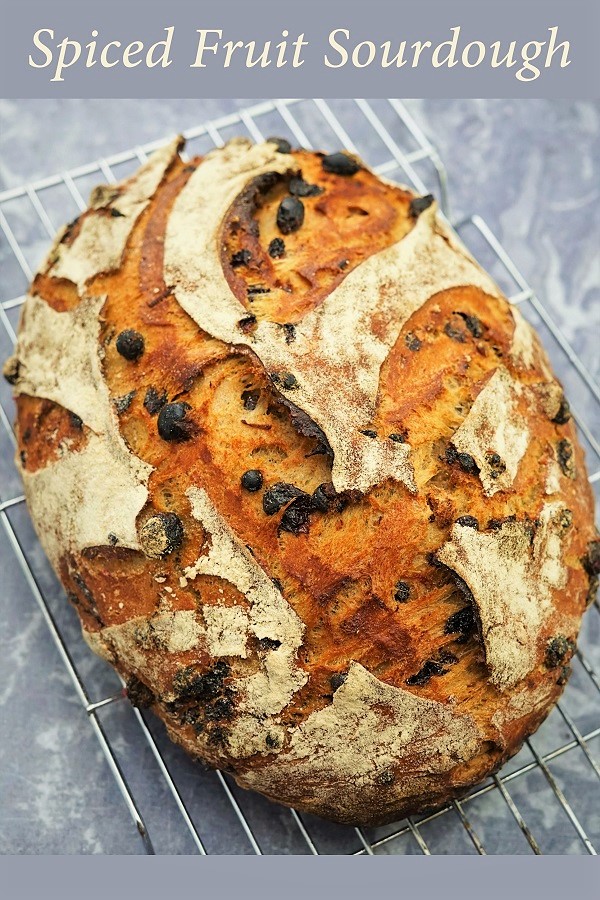Fig & Fennel Sourdough
Fig & Fennel Sourdough is lightly sweet and spicy.
Made with my easy overnight, no-knead method it’s great for both beginners and experienced bakers.
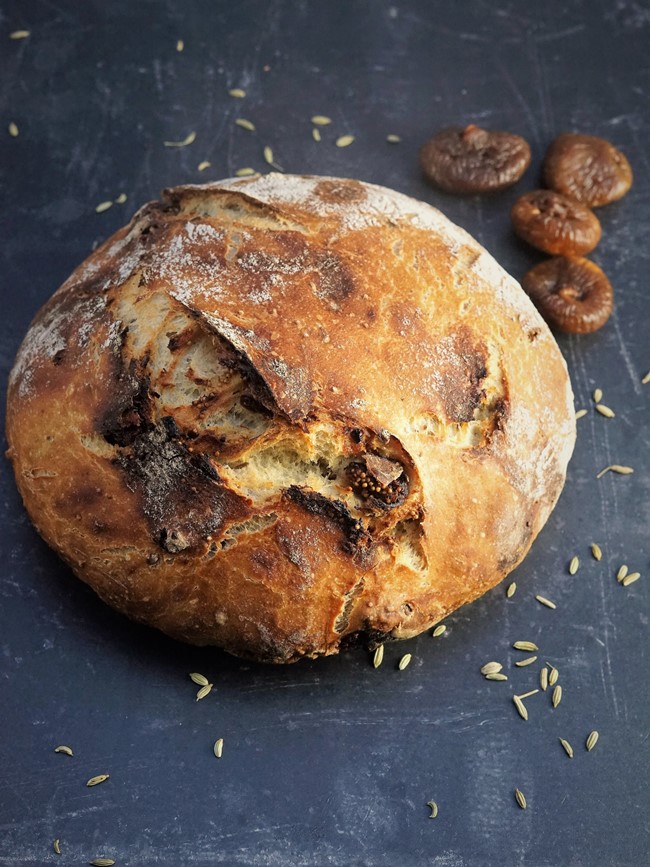
I love it sliced and spread with butter, toasted or not.
With no added sugar, I think its semi sweet flavour is also good with cheese or cured meats.

Not a sourdough baker? In the recipe card at the end, I also tell you how to make this versatile loaf using instant dried yeast.
Jump to Recipe
For some time, I’ve been meaning to develop another sweetish sourdough loaf that could live up to my Spiced Fruit Sourdough.
One of my most popular, and early, blog recipes, I still love its spicy warmth and generous loading of dried fruit.
Finally, I’ve now got around to making a worthy partner to it.
However, I think Fig & Fennel Sourdough‘s charms are a little more subtle.
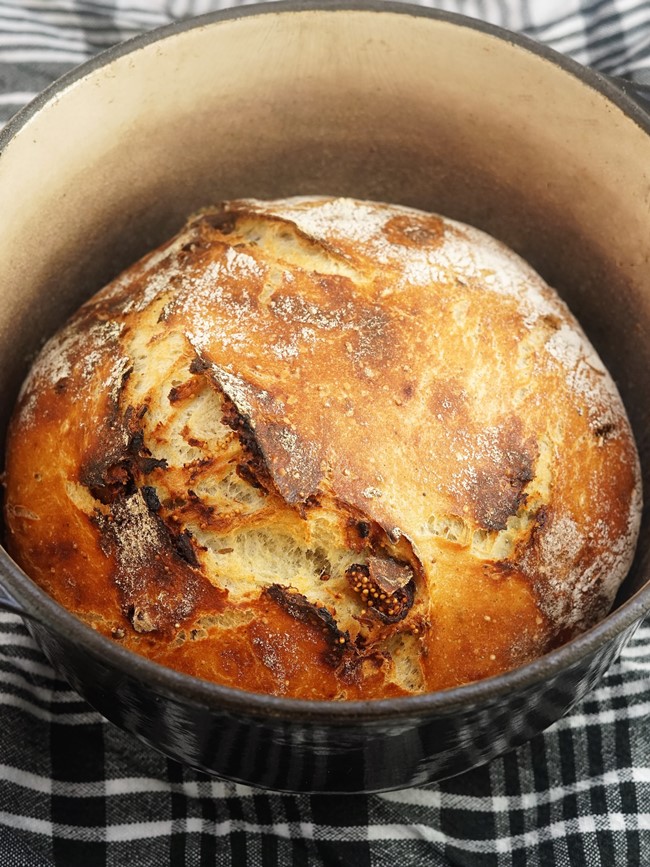
Instead of lots of raisins, currants and orange zest speckled throughout, here I’ve given it occasional chunky nuggets of dried fig.
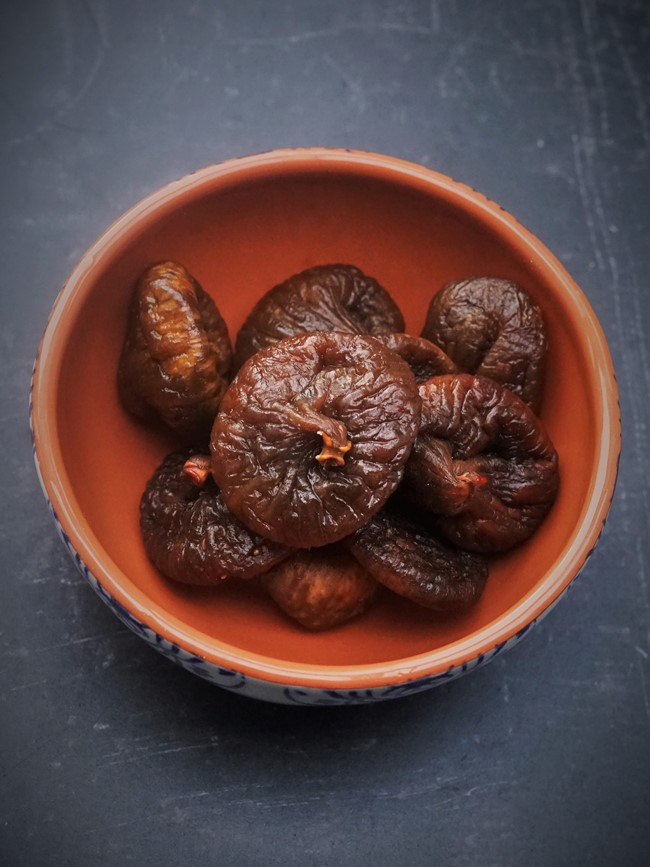
Replacing the bold mixed spice and extra cinnamon I’ve added the delicate hint of fennel seeds, lightly toasted and crushed.

Together, I think these make a beautiful tasting loaf that can happily pair with sweet or savoury accompaniments.
OVERNIGHT, NO-KNEAD SOURDOUGH
Like all my sourdough loaves, Fig & Fennel Sourdough is made using an overnight, no-knead method.
I leave the wetter-than-usual dough overnight and bake it the next day in a heavy, lidded pot.
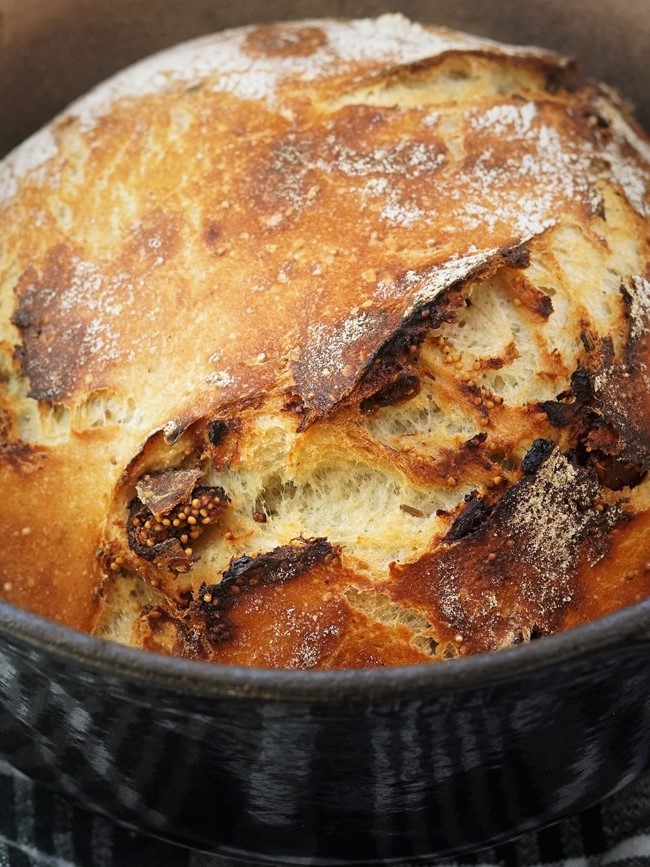
While full instructions are given in the recipe card at the end of this post, if you want to know more about my method, its origins, and why it works, I suggest you read my No-Knead Sourdough post first.
If you don’t already have a sourdough starter, then you can make this simple one from the Real Bread Campaign.
THE DAY BEFORE BAKING
As my no-knead doughs have their initial proof overnight, I mix them up the evening before I want to bake the bread.
This means that I usually feed my sourdough starter mid-morning so it’s nice and lively by the time I need it.
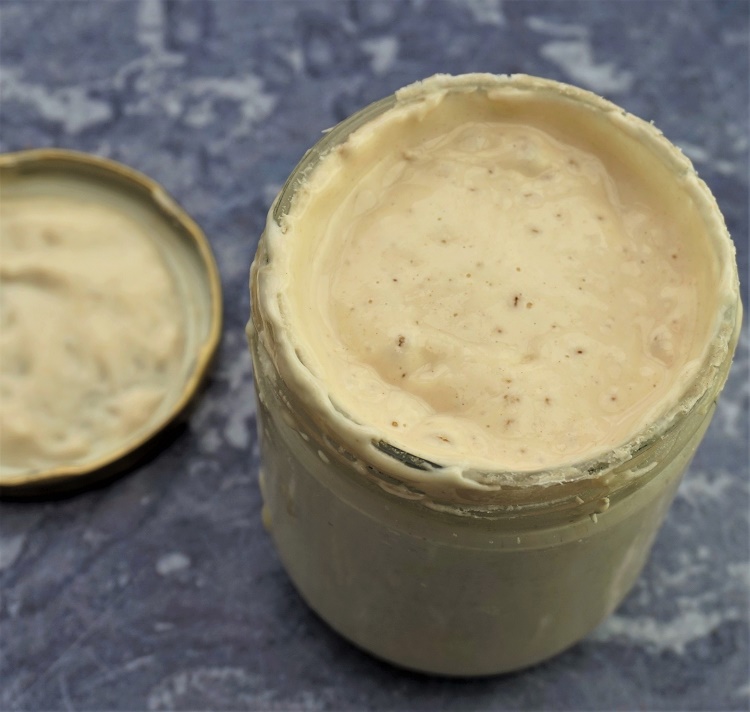
To make the dough for a small loaf, I simply stir together 400 grams of strong bread flour, salt, and the toasted and lightly crushed fennel seeds.
I dissolve 50 grams of my starter in 250 grams/ml of water then vigorously stir that into the flour mixture.
The result is a very wet, shaggy dough.

But don’t worry. This is exactly how it’s supposed to be. It’s this wetness, plus a long proving time, that develop the gluten. And this is precisely why you don’t have to knead it.
If your dough seems dryer, add another splash of water. Flours do absorb different amounts of liquid so it’s hard to be exact regarding amounts.
The dough is then covered and left overnight on the kitchen counter. In warm weather, or if you want to extend the proving time, you can pop it in the fridge instead.
THE NEXT DAY
The next day, the dough should be well risen. You might even get big bubbles on top, as below.
If it isn’t quite ready (maybe the room was rather cool), don’t be tempted to rush to the next step. Just leave for longer.

One tip: I usually make my doughs in a clear bowl. This means that, even if things don’t look very lively on top, you might see activity around the sides in the form of little bubbles. Reassurance that things are happening but need more time.
When you turn out the dough, you should see an intricate network of gluten strands. It’s this which will give structure to your bread.

The next job is to incorporate the figs into the dough, cut into sixths or eighths.
I find the easiest way to do this is to first flatten out the dough a little. Place one third of the figs on it then fold over the sides to cover them.
Repeat with the next third, fold again, then the final third.

Keep folding the dough over itself until the figs are evenly distributed and you have a ball of dough.
As you can see from the photos of my sliced loaf, I could have made a better job of distributing the figs! However, I also didn’t want too many figs on the surface of the dough as they’re likely to burn in the oven, so didn’t spend too long folding them in.
Next, pop the dough (round top facing down) in a floured proving basket or cloth-lined bowl.
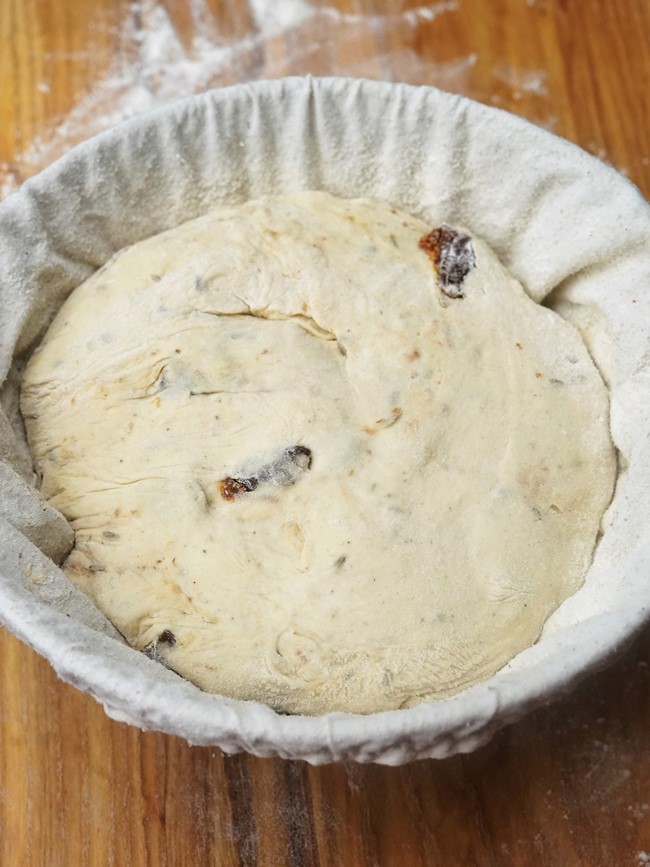
Cover it and leave for around 9o minutes or until the depression left by a finger slowly springs back and leaves a slight indentation.
If it springs back immediately, leave to prove for longer. It really doesn’t pay to rush sourdough.
BAKING
During proving, preheat your oven with a heavy, lidded pot or Dutch oven inside.
When ready to bake, carefully flip the dough into the pot so the rounded side is now uppermost.
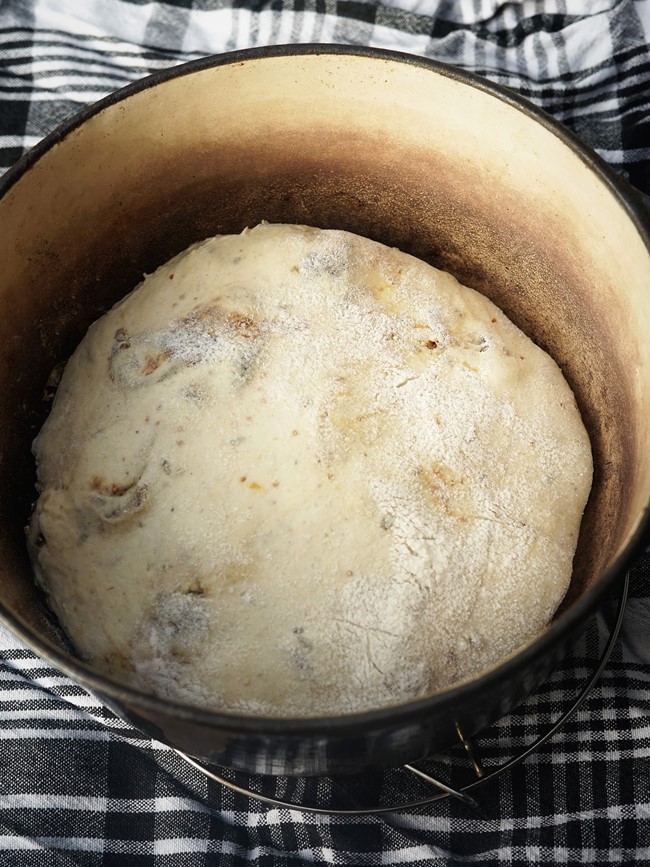
Put on the lid and bake for 30 minutes.
During this time, the steam trapped in the pot will help the bread rise by preventing a crust forming too quickly.
After 30 minutes, you can remove the bread from the pot and put it directly on the oven shelf to finish baking.
This takes 10-15 minutes. Note that this final step is done at a lower temperature.
SERVING & STORING
Like all breads, Fig & Fennel Sourdough should be left to cool before being sliced.
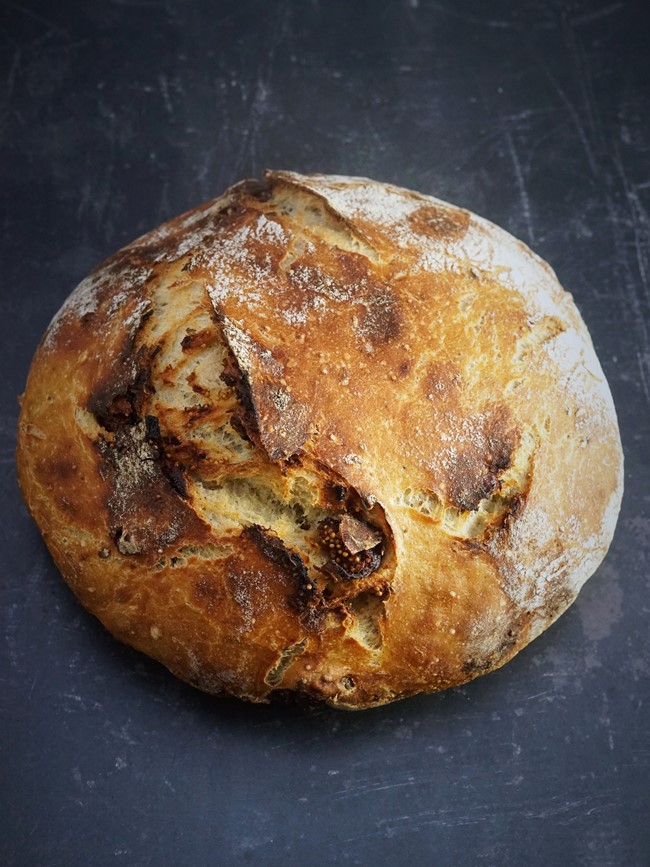
The crust will be wonderfully crunchy. Inside, you should find the classic open crumb of sourdough.
Hopefully, your figs will be a little better distributed than mine 🙂.
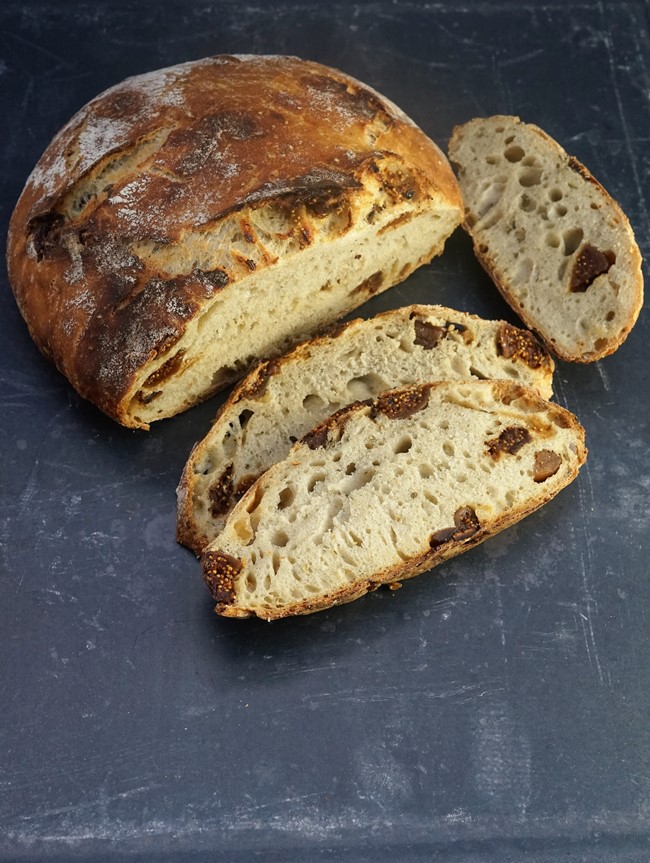
When I cut into a home baked loaf, I always give the first slice a good sniff. Do you?
Here you’ll get earthy tones of fennel which are particularly concentrated in the crust. Alongside that, there’s the delicate sweet perfume of figs.
I defy you not to immediately reach for the butter and eat a chewy, substantial slice straightaway.
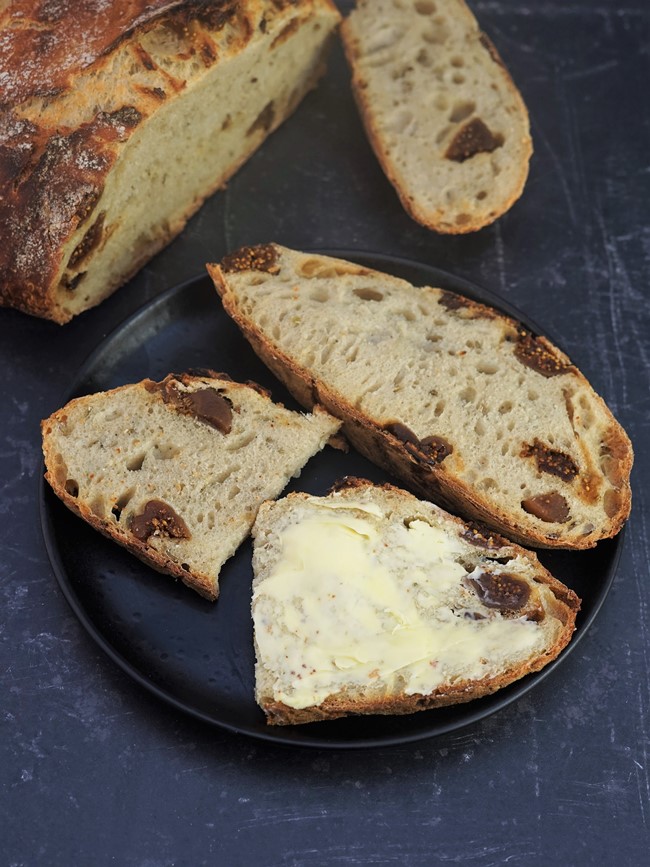
With its light sweetness, the bread is equally good spread with jam or eaten alongside savoury foods like cheese.
When it’s a couple of days old, try Fig & Fennel Sourdough toasted.

Above, I lightly toasted both sides then topped with goat’s cheese before melting under the grill. Delicious!
Although I haven’t tried it yet, I’m sure the bread would also be wonderful alongside cured ham such as prosciutto.
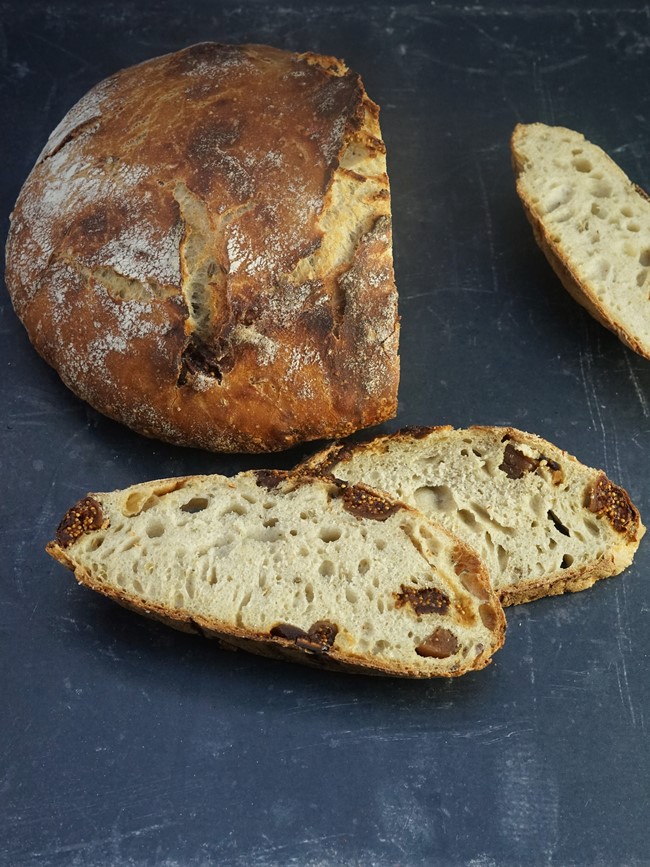
If not eating within 2-3 days, I slice my breads before storing in the freezer. That way I can just take out as many slices as needed with no waste.
If you’ve made this bread, do leave a comment and don’t forget to rate the recipe.

Fig & Fennel Sourdough (no-knead, overnight method)
An easy overnight, no knead sourdough loaf that's lightly sweet and spicy. Eat sliced and spread with butter or eat with cheese. Lovely toasted too.
Can also be made with instant yeast: see Recipe Notes.
Ingredients
- 2 rounded tsp fennel seeds
- 400 g strong bread flour plus extra for dusting
- 1 tsp salt
- 250 g/ml water
- 50 g lively sourdough starter
- 120 g dried figs
Instructions
The evening before baking
-
Put the fennel seeds in a dry frying pan over medium heat and toast until fragrant, stirring often.
Using a pestle and mortar or similar, lightly crush them (can be kept whole if preferred).
-
Put the flour and salt in a mixing bowl and stir in the fennel seeds.
-
Whisk the starter into the water and pour into the flour mixture.
Stir well to bring together into a rough, wet dough. Add a splash more water if needed.
-
Cover the bowl and leave overnight or 14-16 hours.
Tip: to slow things down, put in the fridge.
The next day
-
Snip off any tough stems from the dried figs then chop into sixths or eighths.
-
The dough should be well risen and bubbly: if not then leave for an hour or more longer.
-
Lightly flour the work surface then scrape the dough onto it. Lightly fold and turn a few times to bring it into a smooth ball.
Pat out into a rough rectangle then place one third of the figs over the dough.
Fold over the sides to cover the figs then add another third.
Fold again before adding the remaining figs.
Keep folding until the figs are incorporated through the dough and you have a ball again.
-
Flour a round banneton or cloth-lined bowl and add the ball of dough, rounded top facing downwards. Sprinkle a little flour over then cover.
Set aside to prove for approximately 90 minutes: bread is ready to bake when the depression left by a finger pressed into the dough slowly rather than quickly springs back. If it springs back immediately then leave to prove for longer.
Meanwhile: preheat the oven to its highest setting and put on the middle shelf a cast iron pot or Dutch oven, including its lid.
-
When ready to bake, turn the oven down to 240C / 220 Fan / Gas 9.
Remove the pot from the oven, take off the lid and carefully flip the dough from the banneton or bowl into the pot so the rounded side is uppermost. Put on the lid.
Transfer to the oven and bake for 30 minutes without removing the lid.
-
After 30 minutes, reduce the heat to 220C / 200 Fan / Gas 7.
Remove the pot from the oven, tip the bread out of it, then return the loaf to sit directly on the oven shelf.
Bake for a further 10-15 minutes until the bread is cooked through (it should sound hollow when tapped underneath).
If necessary, reduce the oven temperature to stop the crust over browning before the bread has finished baking.
-
Transfer to a wire rack to cool.
Use within 2-3 days, or can be frozen once completely cold (slicing before freezing means you can take out just as much as you need).
Recipe Notes
To make with instant yeast instead of a sourdough starter
- replace the starter with 1 tsp active dried yeast and stir it into the flour with the salt and fennel seeds.
- use 300 ml of water instead of 250 ml
- proving time is likely to be shorter: 12-14 hours for the initial rise and 30 minutes for the final proof before baking.

